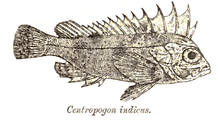Paracentropogon longispinis
| Wispy waspfish | |
|---|---|
 | |
| Scientific classification | |
| Kingdom: | Animalia |
| Phylum: | Chordata |
| Class: | Actinopterygii |
| Order: | Scorpaeniformes |
| Family: | Scorpaenidae |
| Genus: | Paracentropogon |
| Species: | P. longispinis |
| Binomial name | |
| Paracentropogon longispinis (G. Cuvier, 1829)[1] | |
| Synonyms[1] | |
|
Apistus longispinis G. Cuvier, 1829 | |
Paracentropogon longispinis, common name wispy waspfish or sailfin washfish, is a small fish species that belongs to the scorpionfishes family (Scorpaenidae). It is found in the Central Indo-West Pacific.
Physical characteristics
The size of this fish is up to 13 cm (5.1 in). Its body is compressed laterally and is endowed with a dorsal fin starting from the top of the head until joining practically the superior base of the caudal fin. When the dorsal fin is spread, it looks like a toothed crest. The twelve to fifteen spines of the dorsal fin are venomous and there are also seven or eight soft rays. It remains in the substratum and moves by means of its pectoral fins. Its body color is mainly red-brown with one or two bright white spots above the lateral line and it "wears" a bright white mask starting from the top of its head to the inferior lip. Individuals from Thailand have large dark blotches over the body while those from Indonesia and Australia are usually more mottled. It is able to change its color from lighter to darker to a certain extent.[2] In appearance it is somewhat similar to the cockatoo waspfish, Ablabys taenianotus.
Distribution
Paracentropogon longispinis is found in the Central Indo-Pacific region. Its range extends from southern India, Thailand and Malaysia through Indonesia to western, northern and eastern Australia.[2]
Habitat, behavior and diet
Depth from 2 ft to 60 ft on sandy, silty, muddy or rubble bottoms and also in fields of Zosteraceae. It is a nocturnal benthic species, an ambush predator, feeding by hunting from a hide by mimicking a crumpled, dead leaf or a drifting piece of seaweed. It feeds on shrimps and other tiny crustaceans which it sucks into its mouth.
References
- Andrea & Antonnella Ferrrari. Macrolife. Nautilus Publishing, 2003. ISBN 983-2731-00-3
- Ewald Lieske & Robert Myers. Coral Reef Fishes. Princeton University Press,1998. ISBN 978-0691004815
- ↑ 1.0 1.1 Bailly, Nicolas (2013). "Paracentropogon longispinis (Cuvier, 1829)". World Register of Marine Species. Retrieved 2013-12-21.
- ↑ 2.0 2.1 "Paracentropogon longispinis (Cuvier, 1829): Wispy waspfish". FishBase. Retrieved 2013-12-21.